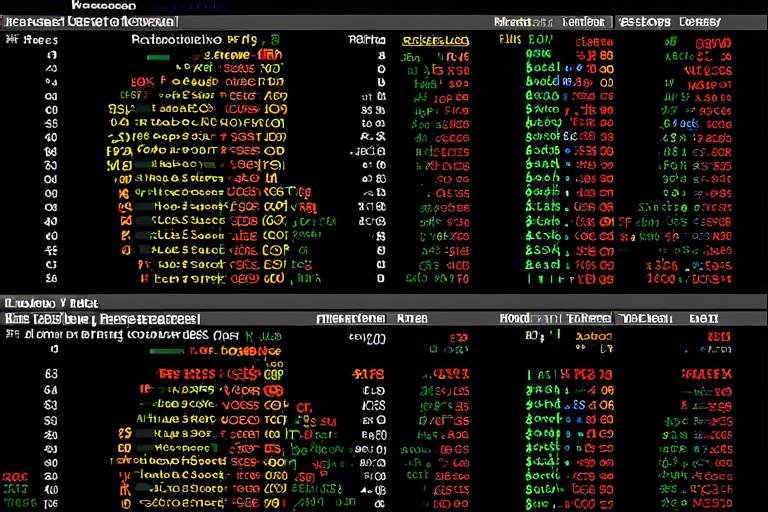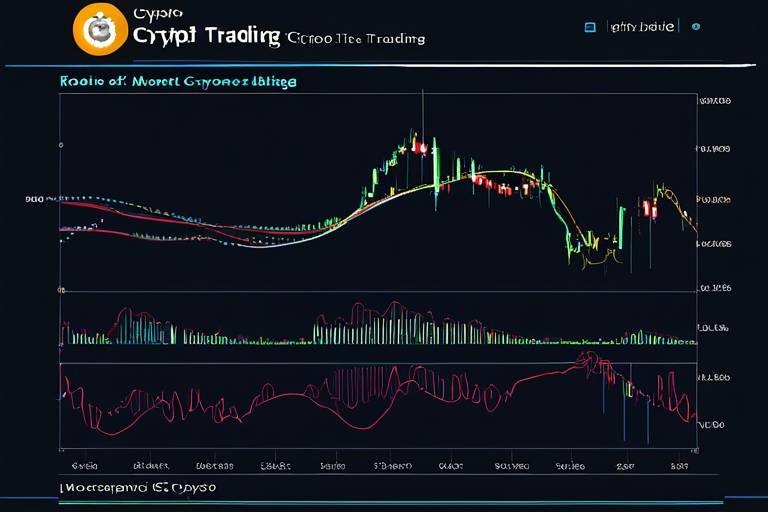The Importance of Creating a Trading Plan Based on Analysis
In the fast-paced world of trading, having a well-structured trading plan is not just a luxury—it's a necessity. Think of it as your personal GPS; without it, you might find yourself lost in a sea of market fluctuations and emotional decisions. A trading plan grounded in thorough analysis serves as your roadmap, guiding you through the complexities of the market while helping you avoid common pitfalls. This article delves into the significance of developing a trading plan based on analysis, emphasizing its role in successful trading and effective risk management.
A trading plan is much more than a set of rules; it’s a comprehensive strategy that outlines your trading goals, risk tolerance, and the specific methods you will use to achieve success. Imagine embarking on a road trip without a map or destination—chaos would ensue! Similarly, a trading plan enhances your decision-making process and promotes disciplined trading practices. By clearly defining your approach, you can minimize emotional trading, which is often the downfall of many traders.
Market analysis is the backbone of informed trading decisions. It involves a thorough evaluation of market trends, patterns, and indicators to identify potential opportunities and risks. Without this analysis, you’re essentially flying blind. By understanding market dynamics, you can make more educated choices, increasing your chances of success. Let’s dive deeper into two primary forms of market analysis: fundamental and technical.
Fundamental analysis is like a detective work; it focuses on economic indicators and financial data to assess the intrinsic value of assets. By understanding the underlying factors that drive market movements, traders can make informed decisions. This method helps you to grasp why a stock might be rising or falling, giving you a clearer picture of the market landscape.
Key economic indicators such as GDP, unemployment rates, and inflation are vital for understanding overall market conditions. These indicators can significantly influence trading strategies. For instance, if unemployment rates are rising, it might signal a weakening economy, prompting traders to rethink their positions. Monitoring these indicators allows traders to adjust their strategies accordingly, ensuring they are always aligned with market realities.
Analyzing a company's financial statements, including balance sheets and income statements, is crucial for evaluating its performance and future potential. These documents provide insights into a company's profitability, debt levels, and cash flow, all of which are essential for making informed trading decisions. By keeping a close eye on these financial metrics, traders can better gauge whether a stock is undervalued or overvalued, guiding their trading actions.
On the flip side, technical analysis involves studying historical price movements and patterns to forecast future price changes. It’s akin to reading a map of past journeys to predict future routes. By utilizing various tools and indicators, traders can identify entry and exit points, maximizing their potential for profit. This method is particularly useful in short-term trading, where quick decisions can lead to significant gains or losses.
Effective risk management is the cornerstone of successful trading. A solid trading plan incorporates risk assessment techniques to protect capital and minimize losses. Without these strategies, even the most promising trades can lead to devastating losses. It’s crucial to establish a framework that allows you to manage risk effectively, ensuring that you can weather the inevitable storms of the market.
Position sizing is a critical component of risk management. It determines the amount of capital to allocate to each trade, helping you manage risk by ensuring that no single trade can significantly impact your overall portfolio. Think of it as spreading your bets in a casino; by diversifying your positions, you reduce the risk of a total loss.
Stop-loss orders are another essential tool for limiting potential losses. By setting predetermined exit points, traders can protect their investments and maintain discipline in volatile markets. This strategy acts like a safety net, allowing you to exit a trade before losses escalate. Implementing stop-loss orders can be the difference between a minor setback and a catastrophic loss.
- What is a trading plan? A trading plan is a comprehensive strategy that outlines your trading goals, risk tolerance, and methods for executing trades.
- Why is market analysis important? Market analysis helps traders make informed decisions by evaluating trends and potential risks, ultimately leading to better trading outcomes.
- What are the two main types of market analysis? The two main types are fundamental analysis, which focuses on economic indicators, and technical analysis, which studies historical price movements.
- How can I manage risk in trading? Effective risk management can be achieved through position sizing and stop-loss orders, helping to protect your capital.

Understanding Trading Plans
A trading plan is not just a piece of paper; it’s your **blueprint** for navigating the often tumultuous waters of the financial markets. Think of it as your personal GPS, guiding you through the ups and downs of trading. Without a clear plan, you might find yourself lost, making impulsive decisions that could lead to significant losses. A well-structured trading plan outlines your strategies, risk tolerance, and goals, serving as a **foundation** for disciplined trading practices. So, what does a good trading plan include?
First and foremost, it should define your **trading goals**. Are you aiming for short-term gains or long-term investments? Understanding your objectives will help tailor your trading approach. Next, you’ll want to consider your **risk tolerance**. This is crucial because it dictates how much of your capital you are willing to risk on any given trade. By establishing this upfront, you can avoid emotional decision-making when the market gets rocky.
Moreover, a trading plan should incorporate specific **strategies** you intend to use. For instance, will you rely on technical analysis, fundamental analysis, or a combination of both? Each method has its strengths and weaknesses, and knowing which one aligns with your trading style is essential. Additionally, documenting your entry and exit strategies can provide clarity and consistency in your trading approach.
Another vital aspect is **performance evaluation**. Your trading plan should include a section where you regularly assess your trades. Are you meeting your goals? What strategies are working, and which ones aren’t? This reflection will not only help you improve but also reinforce your commitment to following your plan.
In summary, a trading plan is your **roadmap** to success in the trading world. It enhances decision-making by keeping your emotions in check and promotes disciplined trading practices. So, before you dive into the market, take the time to craft a solid trading plan. It’s an investment in your trading future!

The Role of Market Analysis
Market analysis is the backbone of informed trading decisions. Imagine setting off on a road trip without a map or GPS; you might end up lost or, worse, in a completely wrong destination. Similarly, traders who neglect market analysis risk wandering aimlessly through the complexities of financial markets. By evaluating market trends, patterns, and indicators, traders can pinpoint potential opportunities while also identifying lurking risks that could derail their strategies.
When we talk about market analysis, we're essentially diving into two main categories: fundamental analysis and technical analysis. Each of these approaches offers unique insights and tools that traders can leverage. Let's break it down a bit further.
Fundamental analysis is all about the big picture. It focuses on economic indicators and financial data to assess the intrinsic value of assets. Think of it as looking under the hood of a car before buying it; you want to know what makes it tick. This method helps traders understand the underlying factors that drive market movements. Key economic indicators, such as GDP growth, unemployment rates, and inflation, serve as essential signposts that provide insights into market conditions.
Monitoring these indicators allows traders to adjust their strategies accordingly. For instance, if a country's GDP is on the rise, it could signal a booming economy, which might lead to increased consumer spending and investment. Conversely, high unemployment rates can indicate economic distress, prompting traders to tread carefully. Here’s a quick look at some key economic indicators:
| Indicator | What It Represents |
|---|---|
| Gross Domestic Product (GDP) | Overall economic performance and growth |
| Unemployment Rate | Health of the labor market and economy |
| Inflation Rate | Purchasing power and cost of living |
In addition to economic indicators, analyzing a company's financial statements is crucial. By examining balance sheets, income statements, and cash flow statements, traders can evaluate a company's performance and future potential. This deep dive helps them make informed decisions about whether to buy, hold, or sell an asset. For example, a company with consistent revenue growth and a healthy balance sheet might be a safer bet than one struggling with debt and declining sales.
On the flip side, we have technical analysis, which is like putting on a pair of glasses to see the market clearly. This approach involves studying historical price movements and patterns to forecast future price changes. Traders use various tools, such as charts and indicators, to identify trends and potential entry and exit points. Imagine trying to catch a wave while surfing; you need to know when and where to paddle to catch the perfect wave, just as traders need to time their trades to maximize profits.
Technical analysis often includes the use of indicators like moving averages, Relative Strength Index (RSI), and Bollinger Bands. These tools help traders make sense of the noise in the market and pinpoint optimal trading opportunities. By combining both fundamental and technical analysis, traders can create a comprehensive view of the market, allowing them to make more informed decisions.
In conclusion, the role of market analysis cannot be overstated. It provides traders with the insights they need to navigate the often turbulent waters of trading. By understanding both fundamental and technical aspects, traders can craft strategies that not only enhance their chances of success but also help manage risks effectively.
Q1: What is the difference between fundamental and technical analysis?
A1: Fundamental analysis focuses on economic indicators and a company's financial health to assess asset value, while technical analysis examines historical price movements to predict future price changes.
Q2: How often should I perform market analysis?
A2: It's advisable to conduct market analysis regularly, ideally before making any trading decisions. This ensures you're informed about current trends and potential risks.
Q3: Can I rely solely on one type of analysis?
A3: While you can use one type of analysis, combining both fundamental and technical analysis often provides a more comprehensive understanding of the market.

Fundamental Analysis
When it comes to trading, understanding the underlying factors that drive market movements is crucial. This is where steps in, acting as a magnifying glass that helps traders scrutinize the economic landscape. By focusing on economic indicators and financial data, traders can assess the intrinsic value of assets, allowing them to make informed decisions. Imagine trying to navigate through a dense fog without a compass; fundamental analysis serves as that compass, guiding traders toward the light of opportunity.
At its core, fundamental analysis revolves around two primary components: economic indicators and company financials. Economic indicators, like GDP growth rates, unemployment figures, and inflation statistics, provide a snapshot of the overall economic health. For instance, if a country is experiencing robust GDP growth, it often signals a thriving economy, which can lead to increased consumer spending and higher corporate profits. Conversely, rising unemployment rates may indicate economic distress, leading traders to rethink their strategies.
To illustrate the importance of these indicators, consider the following key economic indicators that traders should monitor:
- Gross Domestic Product (GDP): Measures the total economic output and growth of a country.
- Unemployment Rate: Indicates the percentage of the labor force that is unemployed, reflecting economic health.
- Inflation Rate: Measures the rate at which the general level of prices for goods and services rises, eroding purchasing power.
In addition to macroeconomic indicators, a trader must also delve into the specifics of individual companies. This is where analyzing company financials becomes essential. By examining financial statements such as balance sheets and income statements, traders can evaluate a company's performance and potential for growth. For example, a company with increasing revenue, strong profit margins, and manageable debt levels is often seen as a solid investment opportunity.
Here's a simple table that summarizes the key components of company financials:
| Financial Statement | Purpose |
|---|---|
| Balance Sheet | Shows the company's assets, liabilities, and equity at a specific point in time. |
| Income Statement | Reports the company's revenues, expenses, and profits over a period. |
| Cash Flow Statement | Details the cash inflows and outflows, indicating the company's liquidity. |
By integrating both economic indicators and company financials into their trading strategy, traders can develop a comprehensive view of the market landscape. This holistic approach not only enhances their decision-making process but also equips them to navigate the unpredictable waters of trading with greater confidence.
In conclusion, fundamental analysis is not just about crunching numbers; it’s about understanding the story behind those numbers. It’s like piecing together a puzzle where each economic indicator and financial statement adds depth to the overall picture, helping traders make educated decisions that align with their trading goals. So, the next time you’re about to make a trade, take a moment to analyze the fundamentals. After all, knowledge is power in the world of trading.
- What is fundamental analysis? Fundamental analysis is the evaluation of a security's intrinsic value by examining related economic and financial factors.
- Why is fundamental analysis important? It helps traders understand market movements and make informed decisions based on economic conditions and company performance.
- How do I perform fundamental analysis? By analyzing economic indicators and company financial statements, you can assess the value and potential of an asset.

Key Economic Indicators
When diving into the world of trading, understanding is like having a compass in uncharted waters. These indicators provide traders with essential insights into the overall health of the economy and can significantly influence market movements. By keeping a close eye on these metrics, traders can make informed decisions that align with the current economic landscape.
One of the most critical indicators is the Gross Domestic Product (GDP). This figure represents the total value of all goods and services produced in a country over a specific period. A growing GDP often signals a healthy economy, which can lead to increased consumer spending and, subsequently, higher corporate profits. Conversely, a declining GDP may indicate economic troubles, prompting traders to adjust their strategies accordingly.
Another vital indicator is the unemployment rate. High unemployment can lead to decreased consumer spending, as fewer people have disposable income. This, in turn, can negatively impact businesses and their stock prices. On the other hand, a low unemployment rate typically suggests a robust economy where more people are earning wages and spending money, creating a favorable environment for investments.
Inflation rates also play a crucial role in trading decisions. Inflation refers to the rate at which the general level of prices for goods and services rises, eroding purchasing power. Moderate inflation is often seen as a sign of a growing economy, but when it spirals out of control, it can lead to economic instability. Traders must monitor inflation closely, as central banks may adjust interest rates in response, which can cause significant market fluctuations.
To summarize, here are some key economic indicators that traders should monitor:
- Gross Domestic Product (GDP): Indicates economic growth or contraction.
- Unemployment Rate: Reflects the health of the job market and consumer spending.
- Inflation Rate: Affects purchasing power and monetary policy decisions.
By staying informed about these indicators, traders can better navigate the complexities of the market. It's essential to incorporate this information into your trading plan, ensuring that your strategies are grounded in a solid understanding of economic conditions. After all, in trading, knowledge is power, and being well-informed can make all the difference between success and failure.

Company Financials
When it comes to trading, understanding a company's financials is like having a treasure map. It reveals the hidden gems of information that can guide your trading decisions. Financial statements, including balance sheets and income statements, are critical documents that provide a snapshot of a company's health. They help traders assess whether a stock is undervalued or overvalued, allowing them to make informed decisions based on solid data rather than gut feelings.
For instance, the balance sheet gives you an overview of what a company owns (assets) and what it owes (liabilities). This snapshot can help you determine the company's liquidity and overall financial stability. A company with a strong balance sheet, showing more assets than liabilities, is often considered a safer investment. On the other hand, if liabilities exceed assets, it may signal financial trouble ahead.
Another key document is the income statement, which outlines a company's revenues, expenses, and profits over a specific period. This statement answers crucial questions like: Is the company making more money than it spends? What are its profit margins? A consistent increase in revenue and profit can indicate a healthy, growing business, while declining figures may raise red flags for potential investors.
To illustrate the importance of these financial metrics, let's take a look at a simplified example in the table below:
| Company | Total Assets | Total Liabilities | Net Income | Revenue |
|---|---|---|---|---|
| Company A | $1,000,000 | $600,000 | $150,000 | $800,000 |
| Company B | $500,000 | $700,000 | -$50,000 | $400,000 |
In this example, Company A has a healthy financial position with total assets exceeding its total liabilities, along with a positive net income. Conversely, Company B's situation raises concerns, as it has more liabilities than assets and a negative net income, suggesting it may not be a wise investment choice.
Ultimately, analyzing company financials allows traders to uncover the underlying value of a stock, making it an essential component of a well-rounded trading strategy. By diving deep into these numbers, you can better navigate the tumultuous waters of the stock market and potentially avoid costly mistakes.
- What are the main financial statements to analyze? The three primary financial statements are the balance sheet, income statement, and cash flow statement.
- How often should I review a company's financials? It's advisable to review financials quarterly and annually, especially before making investment decisions.
- What should I look for in a balance sheet? Focus on the company's assets, liabilities, and the overall debt-to-equity ratio.
- Why is the income statement important? It shows the company's profitability and helps you understand its revenue and expense structure.

Technical Analysis
This article discusses the significance of developing a trading plan grounded in thorough analysis, highlighting its role in successful trading and risk management.
A trading plan serves as a roadmap for traders, outlining their strategies, risk tolerance, and goals. It enhances decision-making and promotes disciplined trading practices.
Market analysis is crucial for informed trading decisions. It involves evaluating market trends, patterns, and indicators to identify potential opportunities and risks.
Fundamental analysis focuses on economic indicators and financial data to assess the intrinsic value of assets. This method helps traders understand market movements and make informed decisions.
Economic indicators such as GDP, unemployment rates, and inflation provide insights into market conditions. Traders must monitor these indicators to adjust their strategies accordingly.
Analyzing a company's financial statements, including balance sheets and income statements, helps traders evaluate its performance and future potential, guiding their trading decisions.
Technical analysis is like putting on a pair of glasses that help you see the market more clearly. Instead of focusing on the fundamentals of a company, technical analysis dives deep into the price movements and trading volumes of assets. By studying historical price data, traders can identify patterns that often repeat themselves, much like recognizing a familiar song on the radio. This method equips traders with the tools they need to predict future price movements and make informed decisions about when to enter or exit a trade.
One of the core principles of technical analysis is the use of charts. Traders utilize various types of charts, such as line charts, bar charts, and candlestick charts, to visualize price movements over time. Each type of chart offers unique insights. For instance, candlestick charts provide information about the opening, closing, high, and low prices within a specific time frame, allowing traders to gauge market sentiment. It's like reading the mood of a crowd at a concert; the patterns can tell you if the audience is excited or bored.
Moreover, technical analysts often rely on indicators to make sense of the data presented in charts. These indicators, such as Moving Averages, Relative Strength Index (RSI), and Bollinger Bands, serve as tools to help traders identify trends and potential reversals in the market. For example, a trader might use the RSI to determine whether an asset is overbought or oversold, much like checking the temperature before deciding whether to wear a jacket. Understanding these indicators can significantly enhance a trader's ability to make timely and profitable trades.
However, it’s important to remember that technical analysis is not foolproof. Just like predicting the weather, it provides probabilities rather than certainties. Market conditions can change rapidly, and unforeseen events can disrupt even the most well-laid trading plans. Therefore, combining technical analysis with other forms of analysis and maintaining a disciplined approach is essential for success in trading.
Effective risk management is essential in trading. A solid trading plan incorporates risk assessment techniques to protect capital and minimize losses.
Position sizing determines the amount of capital to allocate to each trade. It helps manage risk by ensuring that no single trade can significantly impact the overall portfolio.
Stop-loss orders are critical tools for limiting potential losses. By setting predetermined exit points, traders can protect their investments and maintain discipline in volatile markets.
- What is the main goal of a trading plan?
A trading plan aims to provide a structured approach to trading, helping traders to make informed decisions and manage risks effectively. - How often should I review my trading plan?
It's advisable to review your trading plan regularly, especially after significant market changes or personal trading experiences. - Can technical analysis guarantee profits?
No, technical analysis does not guarantee profits. It provides insights and probabilities, but market conditions can be unpredictable. - What are the most common indicators used in technical analysis?
Some common indicators include Moving Averages, RSI, MACD, and Bollinger Bands.

Risk Management Strategies
When diving into the world of trading, one of the most important aspects to consider is risk management. Think of it as your safety net—without it, you might find yourself plummeting into financial chaos. A well-structured trading plan incorporates various risk management strategies that not only safeguard your capital but also enhance your overall trading performance. After all, even the most seasoned traders can face unexpected market volatility, and having a plan in place can mean the difference between a minor setback and a devastating loss.
One of the key components of risk management is position sizing. This refers to the amount of capital you decide to allocate to each trade. Imagine you're at a carnival, and you have a limited number of tickets. You wouldn't spend all your tickets on one ride, would you? Similarly, in trading, position sizing helps you avoid putting all your eggs in one basket. By determining the right amount to invest in each trade, you can mitigate risks and ensure that no single trade can significantly impact your overall portfolio. A common rule of thumb is to risk no more than 1-2% of your trading capital on any single trade.
Another essential tool in your risk management arsenal is the stop-loss order. Think of it as your personal bodyguard in the trading arena. A stop-loss order automatically sells your asset when it reaches a certain price, effectively limiting your potential losses. This is especially crucial in volatile markets where prices can swing dramatically in a short period. Setting predetermined exit points allows you to maintain discipline and prevent emotional decision-making. For instance, if you buy a stock at $50 and set a stop-loss at $48, your maximum loss is capped at $2 per share. This strategy not only protects your investments but also helps you stick to your trading plan, even when the market throws a curveball.
To illustrate the importance of these strategies, let’s take a look at a simple table that compares two traders: Trader A, who uses a solid risk management plan, and Trader B, who trades without any risk management strategies in place.
| Aspect | Trader A (With Risk Management) | Trader B (Without Risk Management) |
|---|---|---|
| Capital Allocation | 1-2% per trade | 50% on a single trade |
| Use of Stop-Loss | Always sets stop-loss orders | No stop-loss orders |
| Emotional Control | Sticks to the plan | Often panics and makes impulsive decisions |
| Long-term Success | Consistent profitability | Frequent losses leading to burnout |
This comparison clearly shows that Trader A, who employs risk management strategies, is more likely to achieve long-term success compared to Trader B, who risks everything on a whim. By incorporating these strategies into your trading plan, you can navigate the unpredictable waters of the market with confidence.
Ultimately, effective risk management is not just about protecting your capital; it’s about creating a sustainable trading practice that allows you to grow and thrive in the long run. So, as you embark on your trading journey, remember that a solid trading plan, complete with robust risk management strategies, is your best ally in achieving your financial goals.
- What is the most important aspect of a trading plan?
A trading plan should include clear risk management strategies to protect your capital and enhance decision-making. - How do I determine my position size?
Your position size should be based on your total capital and the percentage of risk you are willing to take on each trade, typically between 1-2%. - Why are stop-loss orders important?
Stop-loss orders help limit potential losses by automatically selling your asset at a predetermined price, allowing you to maintain discipline in trading.

Position Sizing
This article discusses the significance of developing a trading plan grounded in thorough analysis, highlighting its role in successful trading and risk management.
A trading plan serves as a roadmap for traders, outlining their strategies, risk tolerance, and goals. It enhances decision-making and promotes disciplined trading practices.
Market analysis is crucial for informed trading decisions. It involves evaluating market trends, patterns, and indicators to identify potential opportunities and risks.
Fundamental analysis focuses on economic indicators and financial data to assess the intrinsic value of assets. This method helps traders understand market movements and make informed decisions.
Economic indicators such as GDP, unemployment rates, and inflation provide insights into market conditions. Traders must monitor these indicators to adjust their strategies accordingly.
Analyzing a company's financial statements, including balance sheets and income statements, helps traders evaluate its performance and future potential, guiding their trading decisions.
Technical analysis involves studying historical price movements and patterns to forecast future price changes. It equips traders with tools to identify entry and exit points.
Effective risk management is essential in trading. A solid trading plan incorporates risk assessment techniques to protect capital and minimize losses.
Position sizing is one of the most critical aspects of a trading plan. It dictates how much capital you will allocate to each trade, which ultimately influences your risk exposure. Think of it as the foundation of your trading house; without a solid base, everything else can come crashing down. Proper position sizing ensures that no single trade can significantly impact your overall portfolio, allowing you to trade with confidence and discipline.
To effectively determine your position size, you need to consider several factors:
- Account Size: The total amount of capital you have available for trading.
- Risk Tolerance: The percentage of your account that you are willing to risk on a single trade.
- Trade Setup: The distance between your entry point and your stop-loss level.
For example, if you have a trading account of $10,000 and you are willing to risk 2% on a single trade, your maximum risk per trade would be $200. If your entry point is at $50 and your stop-loss is set at $48, the risk per share is $2. To find out how many shares you can buy, you would divide your maximum risk by the risk per share:
Maximum Risk per Trade $200 Risk per Share $2 Position Size Maximum Risk / Risk per Share Position Size $200 / $2 100 shares
By calculating your position size, you can ensure that you are not overexposing yourself to risk, which is especially crucial in volatile markets. Remember, the goal is to preserve your capital while allowing it to grow over time. Position sizing is not just about numbers; it's about creating a safety net that lets you trade with peace of mind.
Position sizing is the process of determining how much capital to allocate to a specific trade based on your overall trading strategy and risk tolerance.
Position sizing is important because it helps manage risk and ensures that no single trade can significantly impact your trading account, allowing for more disciplined trading.
You can calculate your position size by dividing your maximum risk per trade by the risk per share. This ensures that you stay within your predetermined risk limits.
Yes, position sizing can change based on your account size, risk tolerance, and market conditions. It's essential to regularly reassess your position sizing strategy.

Stop-Loss Orders
This article discusses the significance of developing a trading plan grounded in thorough analysis, highlighting its role in successful trading and risk management.
A trading plan serves as a roadmap for traders, outlining their strategies, risk tolerance, and goals. It enhances decision-making and promotes disciplined trading practices.
Market analysis is crucial for informed trading decisions. It involves evaluating market trends, patterns, and indicators to identify potential opportunities and risks.
Fundamental analysis focuses on economic indicators and financial data to assess the intrinsic value of assets. This method helps traders understand market movements and make informed decisions.
Economic indicators such as GDP, unemployment rates, and inflation provide insights into market conditions. Traders must monitor these indicators to adjust their strategies accordingly.
Analyzing a company's financial statements, including balance sheets and income statements, helps traders evaluate its performance and future potential, guiding their trading decisions.
Technical analysis involves studying historical price movements and patterns to forecast future price changes. It equips traders with tools to identify entry and exit points.
Effective risk management is essential in trading. A solid trading plan incorporates risk assessment techniques to protect capital and minimize losses.
Position sizing determines the amount of capital to allocate to each trade. It helps manage risk by ensuring that no single trade can significantly impact the overall portfolio.
Stop-loss orders are critical tools for limiting potential losses in trading. Imagine you're driving a car and you hit a slippery patch; you instinctively hit the brakes to avoid a crash. Similarly, stop-loss orders act as your brakes in the trading world. By setting predetermined exit points, traders can protect their investments and maintain discipline in volatile markets.
When you place a stop-loss order, you're essentially saying, "If the price drops to this point, automatically sell my asset." This automatic response helps you avoid the emotional rollercoaster that often leads to poor decision-making. For instance, if you buy a stock at $50 and set a stop-loss at $45, you’re limiting your potential loss to just $5 per share. This strategy is especially useful in fast-moving markets where prices can change rapidly.
Moreover, stop-loss orders can be categorized into different types:
- Fixed Stop-Loss: A specific price point is set, and the order triggers if the asset hits that price.
- Trailing Stop-Loss: This adjusts automatically as the asset price moves in your favor, allowing you to lock in profits while still protecting against losses.
Utilizing stop-loss orders is not just about protecting your capital; it's also about maintaining a disciplined approach to trading. By sticking to your stop-loss strategy, you can avoid the temptation to hold onto losing positions, hoping for a turnaround. Remember, in trading, it's often not about how much you make but how much you can keep!
1. What is a stop-loss order?
A stop-loss order is an instruction to sell an asset when it reaches a certain price, helping to limit potential losses.
2. How does a trailing stop-loss work?
A trailing stop-loss moves with the market price; it locks in profits by adjusting the stop-loss level as the price increases.
3. Can I change my stop-loss order once it’s set?
Yes, you can modify or cancel your stop-loss order as long as it has not yet been triggered.
4. Are stop-loss orders guaranteed?
No, stop-loss orders are not guaranteed. In fast-moving markets, the execution price may differ from the stop-loss price due to slippage.
Frequently Asked Questions
- What is a trading plan?
A trading plan is essentially your roadmap for trading. It outlines your strategies, risk tolerance, and goals. Think of it as a guide that helps you navigate the often tumultuous waters of the trading world, ensuring that you make informed decisions and stick to disciplined practices.
- Why is market analysis important?
Market analysis is crucial because it provides you with the insights needed to make informed trading decisions. By evaluating market trends, patterns, and indicators, you can identify potential opportunities and risks. It's like having a compass in a dense forest; it directs you towards profitable trades while steering you away from pitfalls.
- What is fundamental analysis?
Fundamental analysis focuses on economic indicators and financial data to assess the intrinsic value of assets. It helps you understand the underlying factors that drive market movements, enabling you to make informed decisions based on a company's financial health and broader economic conditions.
- What are key economic indicators to monitor?
Key economic indicators include GDP, unemployment rates, and inflation figures. By keeping an eye on these indicators, you can gauge the overall health of the economy and adjust your trading strategies accordingly. It’s like checking the weather before heading out; you want to be prepared for what’s ahead!
- How does technical analysis work?
Technical analysis involves studying historical price movements and patterns to forecast future price changes. By analyzing charts and using various indicators, you can identify potential entry and exit points, giving you an edge in your trading decisions.
- What are some effective risk management strategies?
Effective risk management strategies include position sizing and using stop-loss orders. Position sizing helps you determine how much capital to allocate to each trade, while stop-loss orders protect your investments by setting predetermined exit points to limit potential losses.
- What is position sizing?
Position sizing is the process of determining how much capital to allocate to each trade. It’s a vital aspect of risk management because it ensures that no single trade can significantly impact your overall portfolio. Think of it as balancing your diet; you want to make sure you’re not overindulging in one area!
- How do stop-loss orders work?
Stop-loss orders are predefined exit points that you set to limit potential losses on a trade. By automatically selling an asset when it reaches a certain price, you can protect your investments and maintain discipline, especially in volatile markets. It’s like having a safety net; it catches you before you fall too hard!



















